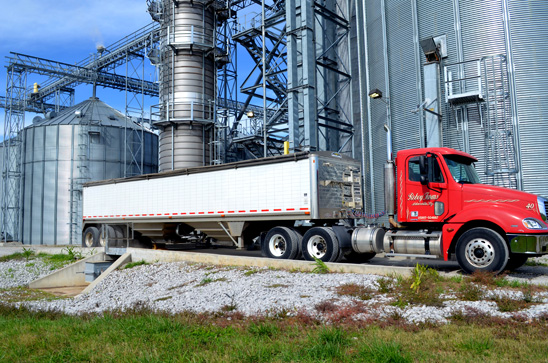Producers see benefits of adding on-farm storage
Producers see benefits of adding on-farm storage

As owner of one of the state’s largest dairies, Logan County farmer Lee Robey is a very busy man. In the fall, he and his crew are all-hands-on-deck, as they work to harvest his grain crops in a timely manner to maintain optimum quality. Any unnecessary downtime could be a real inconvenience and detrimental to the harvest progress.
To make the harvest run smoother, Robey has taken some of his profits from the past few years of record grain prices and invested in on-farm storage. In the past four years, he’s nearly doubled his storage capacity.
“It does give you flexibility, and in most cases, futures prices and basis will pay for your storage costs and facility maintenance,” he said. “It also helps us with labor management and allows us to keep our grain equipment running in the field instead of waiting in line at an elevator.”
According to grain experts at the University of Kentucky College of Agriculture, Food and Environment, Robey is not the only Kentucky farmer seeing the benefits of adding on-farm storage structures.
“A lot of grain farmers have reinvested their profits from the past few years into infrastructure,” said Sam McNeill, UK agricultural engineer. “Last year, harvesting in a timely manner became a real problem with some producers waiting as long as four hours to unload grain at the elevator.”
More Kentucky farmers are seeing the positives of on-farm storage this year as tight profit margins and high yields have forced some to rent storage or seek temporary or alternative storage structures in hopes of higher prices.
“The silo bags that are really popular in South America have made their way to the U.S.,” said Todd Davis, UK grain marketing specialist. “While those bags are an inexpensive way to store grain, they are designed to turn corn material into silage. So it’s important for producers to keep the grain in good condition, as it could really damage the quality. Alternative storage structures are a risky proposition, but you can make a lot of money if it works.”
While some producers may be feeling pressure to add on-farm storage structures to their farm, the decision to do so should be based on each individual’s situation, UKAg experts said.
“Producers should scale their storage size to that of their operation,” McNeill said. “Producers in areas of Kentucky that have large production or increased production and don’t have a lot of storage capacity are looking at on-farm storage structures to help them harvest more smoothly and market more easily.”
“Understanding what you need from the market to cover costs like infrastructure and inputs is going to be very individual specific, but you also have to take into account family living expenses and existing debt,” Davis said. “Accounting for all of these costs is critically important when making a business decision.”
Developing a written marketing plan can also help producers market their grain more efficiently and more easily weather price fluctuations, Davis said.
“They need to know what their costs are and have an idea of what they want to do and when, to help them make better management decisions and help remove some of the emotion that comes from watching grain prices go up and down,” he said.
Biosystems Ag Engineering Crops Extension


